 Leading Blog | Posts by Month |
 Leading Blog | Posts by Month |
01.31.23

LeadershipNow 140: January 2023 Compilation
See more on
Posted by Michael McKinney at 07:21 AM
01.30.23

Stop Letting the Latest Trend Dictate How You Run Your Company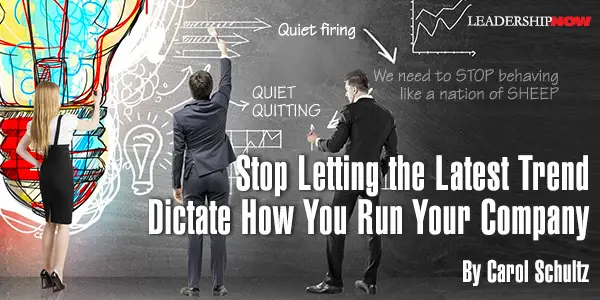
QUIET QUITTING. Quiet firing. Quiet thriving. What will be the next viral workplace term? Today’s businesses aren’t plagued by these “new” movements—except for the reactionary movement of buying into the latest buzzword and letting it affect their workplace culture. As talked about in this Business Insider article, these trends have caused panic among leaders in all industries, who are now looking to combat these “new” issues, and consultants are right there with them, offering all sorts of “solutions.” A quick search on LinkedIn will bring you to the pages of coaches and consultants who claim to solve “quiet quitting,” using the keyword to garner clients. The truth: These aren’t new problems. These are age-old issues with trendy, new names. “Quiet quitting” is a rebrand of employee disengagement, describing workers who choose to coast through their work hours instead of putting in the effort. “Quiet firing” came about in response to it, describing the passive-aggressive behavior of managers who withhold opportunities from quiet-quitters instead of firing them altogether. The list of new terms goes on and on, but the point is that while these problems can’t be ignored, they aren’t new trends. There’s one common denominator behind them: The majority of today’s organizations aren’t talent-centric. If a company puts its talent first in its strategy and decision-making, these problems won’t arise in the first place. THE “WHY” BEHIND THE TRENDS Rather than looking to protect your company from the latest viral movement, look at why your employees are disgruntled, disengaged, or quitting in the first place. Chances are, it’s for one of the following reasons: They don’t feel connected to the vision of the business, they don’t feel heard or appreciated, there’s a lack of communication, or there’s a lack of opportunity for growth. The simplest way to ensure these needs are met is to center your company around your employees. START AT THE TOP Asking questions is the best way to start changing your company. Where are your company’s decisions primarily being made? Usually, they’re being made within your executive team. So, when thinking about your employees and talent strategies, that’s where you must start: at the top. Ask each person on your executive team what the vision is for your company. Then prepare to be surprised: Your CEO, CFO, and COO may very well give different answers. When your executives have different visions, you have a problem. Multiple visions make for stagnant companies, with each member of your team rowing toward a different destination. There’s no way to reach a goal when everyone is rowing out of sync. How do you work for a company where your leaders each want to achieve something different? You don’t. This is what leads to employee turnover. Company leaders and managers must be able to communicate the same vision. It sounds minute, but this one statement sets the tone for all subsequent actions. When your leaders are aligned, your talent will hum at the same frequency, and you’ll notice more engagement and connection to the greater purpose of your business. When your talent doesn’t know the company’s vision in the first place, disconnection can easily become the norm. VIEW FEEDBACK AS A PLUS As a business committed to focusing on your talent, you must commit to hearing from employees. Being talent-centric isn’t about posting “we put employees first” on your website or on a placard on an office wall; it’s about making time to hear from your employees and truly listening. I call this a culture of feedback. This, too, starts with the executive team. Those in leadership positions set the tone for the entire organization, so everyone must openly show their commitment to wanting feedback from any employee and also giving their own. Feedback must be offered without fear of repercussions. Open your schedule—and your team’s schedules—to allow one-on-one meetings with any worker. Listening to your staff will establish trust among peers, managers, and higher-ups, which leads to loyalty and engagement. Plus, these one-on-one meetings provide a great time to check in with employees and ask what they need, what their goals are, and how you can help them reach them. Maybe all they need is a mental health day or advice on a new project. By having proactive conversations, you’ll prevent disengagement on their end. COMMUNICATE EXPECTATIONS Putting your talent first starts at the very beginning: the interview process. Stay true to the position you’re offering. Don’t embellish or leave out significant (or unsavory) duties the job requires. Most importantly, don’t downgrade the hours needed for the position. Imagine you’ve accepted a 10-hour-per-week position. After the first month, you realize you’ve been working 30 hours to keep up with the workload. If there’s any way to cause an employee to disengage at work, this is it. Be honest from the very first conversation. It will ultimately lead you to weed out workers who don’t fit your expectations. IT’S TIME TO REFOCUS It’s time to look within—and not outside of—your organization for solutions to your problems. Once you take the steps to refocus your company on the people within it, these problems will start to fade.  
Posted by Michael McKinney at 07:31 AM
01.28.23

The Top Toys from the Year You Were Born
Jacob Osborn and Peter Richman put together a list of the top holiday toys in the U.S. through the years over on Stacker. Toy shopping has transformed over the past 100 years due to advancements in the products or the marketplace. Stacker searched for products from 1920 to today that caught hold of the public zeitgeist through novelty, innovation, kitsch, quirk, or simply great timing, and then rocketed to success. The list was curated using national toy archives and data curated by The Strong National Museum of Play. Some items remain curious relics of the past, while others are essentially as iconic now as they were upon their debut. Each one also functions as a window into American culture.”
Posted by Michael McKinney at 06:30 PM
01.27.23

When Everyone Leads the Toughest Challenges Get Seen and Solved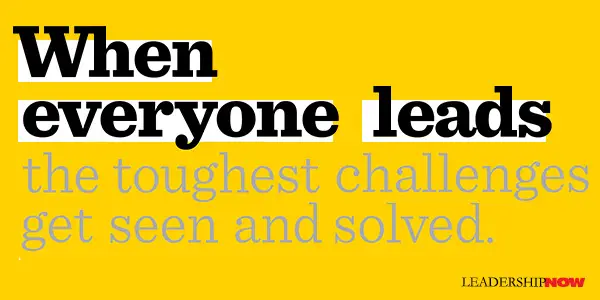
LEADERSHIP is an action, not a position. Leaders can come from anywhere. Anyone can step up and take responsibility. Leadership begins by taking responsibility for the gap between what is and what should be. Ed O’Malley and Julia McBride believe that anyone can lead, not by being a leader, but by exercising leadership. And When Everyone Leads, our tough challenges get seen and solved. We need the diversity of thought that can come from anywhere. We need to choose leadership over comfort. When authorities—the folks in the top jobs—empower others to lead, their own jobs get easier. When everyone else—the folks not in authority—starts leading, their work becomes more rewarding. The first step in leading change is to identify The Gap. “Leadership always starts with dissatisfaction. No one exercises leadership unless they are unhappy with the current reality.” It means acknowledging the concerns and facing the hard choices that must be made to move in the direction of our aspirations. Our research shows that closing The Gap takes leadership from the many, not the few. Real progress on the toughest challenges facing your company or community requires more people looking at The Gap, voicing concerns and aspirations, balancing pragmatism and idealism. In leading any change, you will encounter barriers. If you don’t understand where they come from and address them, you make things more difficult. In your efforts to close The Gap, the following five barriers are the most common:
Once you acknowledge and identify The Gap, you will make more progress when you do these five things:
Keep in mind, if there is no heat—if people don’t feel uncomfortable—there is no motivation to engage and change. No one will move if the heat in a situation is too low. You have to manage the heat. There has to be enough heat for people to change but not so much that they engage in unproductive behaviors. Too much heat and a flight, fight or freeze response kicks in. The right amount of heat fosters curiosity and learning. The authors have tried to share lessons from their specific work at the Kansas Leadership Center to inspire engagement for leading change on tough issues. While some declarative statements miss the nuances of leading, their approach is spot on. If you are apprehensive about stepping up and leading, then you will be encouraged to act after reading the examples and principles found in When Everyone Leads. 
Posted by Michael McKinney at 06:59 AM
01.26.23

Leading Thoughts for January 26, 2023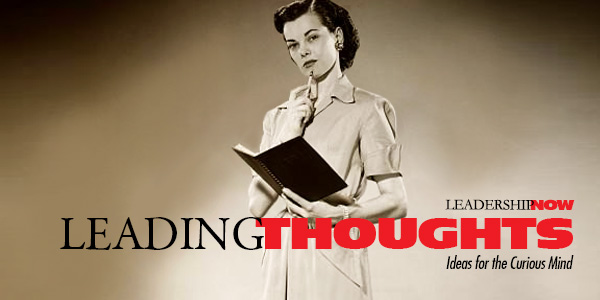
IDEAS shared have the power to expand perspectives, change thinking, and move lives. Here are two ideas for the curious mind to engage with: Niccolò Machiavelli on resistance to change: “It must be remembered that there is nothing more difficult to plan, more doubtful of success, nor more dangerous to manage than a new system. For the initiator has the enmity of all who would profit by the preservation of the old institution and merely lukewarm defenders in those who gain by the new ones.” Source: The Prince Translated by Thomas G. Bergin (1947) George Steele and Paul Kircher on innovation: “Picture a man in charge of weapons for a medieval king. If he is scientific minded, he will try to improve his bows and arrows by working on different parts of the product. The searcher may be assigned to study the properties of feathers. He will try to improve the breed of birds, study feather selection, and storage, investigate whether they should be trimmed ½- or ¾-inch wide, and so on. This man will conduct what many call ‘scientific research’ for years. He may achieve many improvements, giving arrows better stability and accuracy; but what is the chance that such a man will ever invent a gun? If he should hear about one, the chances are he will do his best to point out how unstable and dangerous it is to carry a powder horn, how inaccurate the new guns are, and how many families depend for their livelihood on the chicken feather business.” Source: The Crisis We Face: Automation and the Cold War Look for these ideas every Thursday on the Leading Blog. Find more ideas on the LeadingThoughts index.
Posted by Michael McKinney at 06:44 AM
01.24.23

Intentional Leadership: The Big 8 Capabilities for Leading Well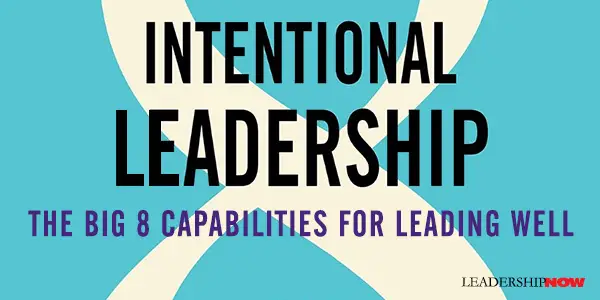
THE context of leadership has changed. It is more complex, and values that must be addressed have shifted. What we once glossed over now requires our attention and action. Mostly it requires that we be more intentional about relationships. Rose Patten puts it this way in Intentional Leadership: “The spotlight on leadership has moved to how people lead in challenging and changing circumstances. Innovative models, digitalization, technologies—these are all important. But what matters more is how leaders lead other people.” Good leadership happens when someone, by intention, has a positive impact—whether through empathy, inspiration, or wisdom. While some people seem to do this naturally, most of us—if we have the will—can learn it and continue to do it better. We must begin with our mindset. Our mindsets have consequences. This is where we begin to improve our influence and impact. Patten identifies four common beliefs that impede our success as a leader:
If these false beliefs are part of our mindset, then we will not take the steps necessary to respond to our leadership environment with the renewed capabilities that are required of us. They can become blind spots—unspoken beliefs that control our behavior—that, on a conscious level, we would never admit to. So, there is a need to examine ourselves to see where our behaviors don’t line up with what we say we believe. Leaders are dependent upon, and guided by, their own individual level of self-awareness, gained from self-reflection and feedback from others. This enables them to take deliberate, intentional action to check and adjust their mindset. The Big 8 The Big 8 capabilities have been created to address the needs of the changing leadership environment and to counter the false beliefs that can creep into our thinking. A healthy self-awareness is the sine qua non for all of the Big 8. They are not a definitive list of desired traits but a roadmap to self-reflection and intentional renewal for the leadership context we face today. It does not address all the skills that leaders are expected to have. Rather, the Big 8 offers the solution for leaders to become more effective and better balanced in their leading.
The Big 8 #1: Personal Adaptability Adaptability is the capacity that matters most. “Adaptability, open-mindedness, and renewal are overlapping, one leading to another. Open-mindedness enables adaptability to occur; with adaptability, the hope of renewal is possible.” It is what it means to be a lifelong learner. Adaptability requires accepting diverse views and the willingness to be uncomfortable. The Big 8 #2: Strategic Agility In a consistently changing environment, strategies are short-lived. Success depends on commitment and our ability to be adaptable and creative. It is a mindset issue. Can we adapt to the “reality that strategies do have a shelf life no matter how successful they were in the past?” The leader needs the mindset of what Patten calls the three A’s: Appraising constantly, adjusting courageously, and acting urgently. “The leader needs strategic agility, beginning with personal adaptability and overlaid with critical thinking.” The Big 8 #3: Self-Renewal Teachability—discovering what you do not know. Arrogance leads to regret. Patten reflects, “In my own leadership experiences, learning does come from mistakes and from admitting to not having all the answers. Becoming teachable and open and being around other great insightful people, including mentors, has helped me tremendously. Having a need to know things and a continuing curiosity also feed teachability. Whether it comes from innate curiosity or through intentionality – either is welcome and impactful in becoming a better leader.” The Big 8 #4: Certainty of Character “Character is not a victim of circumstances; it survives in spite of them.” Character is doing the right thing in spite of circumstances. Patten offers five checks to guide leaders: Keeping your word (Integrity), Looking to self for cause (Responsibility), Sticking your neck out (Courage), Letting go of others’ mistakes (Forgiveness), and Putting self in others’ shoes (Empathy). The Big 8 #5: Empathy Quite naturally, empathy helps you to connect with others. Not only understanding others but understanding your impact on them—putting yourself in their shoes. It allows you to adjust your behavior to the situation. The Big 8 #6: Contextual Communication Leaders must explain not just the what but the why—the context. “Communicating without “the why,” without the purpose, but with just ‘the what’ doesn’t do it in today’s workforce. More than an expression of respect, communicating ‘the why’ engenders trust.” Leaders must go beyond the analytical mindset to consider emotions and understand others’ states of mind by recognizing preconceived mindsets. The Big 8 #7: Spirited Collaboration Patten calls it spirited collaboration because it enables and encourages “dissent, with the ultimate objective of arriving at a better outcome. A harmonious group of like minds becomes an echo chamber of agreement. A leader who doesn’t allow diverse opinions and ideas for improvement will perform suboptimally.” Collaboration means listening well, understanding motivations, and depersonalizing ideas. The Big 8 #8: Developing Other Leaders—Not Only Followers “Shifting the way in which we lead from command and control to connect and collaborate means that leaders move more to empowerment and distributed leadership in the workplace.” Developing leaders is not just a matter of time and experience. It is more than just teaching technical skills. A development approach of 70-20-10 is recommended: 70% is real-time apprentice-like learning, 20% is mentoring, and 10% is classroom-type resources. 
Posted by Michael McKinney at 10:43 AM
01.20.23

Experiential Intelligence: What It Is and How to Grow It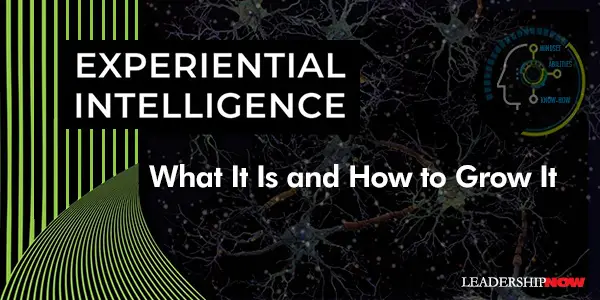
WHEN WE THINK of success and influence, there’s more to it than just IQ and EQ. What pulls it all together and contributes to our ability to show up and achieve our goals is the sum total of our experiences and what we take away from them. What we’re talking about is our Experiential Intelligence or our XQ. In Experiential Intelligence, author Soren Kaplan describes XQ as “the combination of mindsets, abilities, and know-how gained from your unique life experience that empowers you to achieve your goals.” He adds, “XQ provides a holistic way to understand what’s needed for success in today’s world by getting in touch with the accumulated wisdom and talents you have gained over time through your lived experience.” Lessons learned from our experiences alone do not make for Experiential Intelligence alone. XQ is a framework that provides a lens through which we can view our experiences. We create meaning or intelligence through a process that is based on three elements or building blocks: Mindsets: Your attitudes and beliefs about yourself, other people, and the world. These attitudes and beliefs can either get in your way or propel you forward. When you fully tap into your XQ you’re able to uncover the self-limiting belief you hold. Abilities: Your competencies that help you integrate your knowledge, skills, and experiences so you can respond to situations in the most effective way possible. “Abilities are specific competencies that bridge your mindsets with your know-how. Your abilities represent broader approaches to how you do what you do, so you can apply what you know how to do in different contexts. Your mindsets guide what you see as possible as desirable, which influences where and how you decide to apply your abilities.” Know-How: Your knowledge and skills. This includes both formal education and tacit knowledge that is learned through practice or performing.
Mindsets, abilities, and know-how collectively comprise XQ. When we treat these components as building blocks, with know-how as the base, abilities in the middle, and mindsets at the top, we get a progression from the tangible to the more amorphous when it comes to self-awareness. Understanding that you possess certain knowledge and skills generally comes more easily than seeing your broader abilities. Recognizing that you possess specific mindsets that influence your thinking and behavior is even more challenging. You can grow your XQ. Unfortunate experiences in your life can prepare you for a better future. “Embracing your XQ means looking for the unrealized assets you already possess and you’ve developed because of your experiences, whatever they may be.” You grow your XQ in three ways: Reinventing your attitudes and beliefs (mindsets), Enhancing your abilities, and Building your knowledge and skills. Going deeper into your mindsets is the powerful thing you can do to drive significant change and breakthroughs. Look for connections you have made between things that don’t belong together. Look for links between your past experiences and how they influence you today and decide what to keep and what to let go of or reframe. It usually requires taking a broader view of your experiences. Kaplan provides specific questions and methods to dig into each of the three areas. Online you can take the XQ Assessment. Kaplan also goes into developing for your team and organization using five strategies: Connecting the dots to find focus, Rewriting unwritten rules, Exploring uncertainty to discover new opportunities, Crating experiences to spark positive change, and Amplifying strengths to amplify impact. Properly understood, XQ goes beyond just finding more creative solutions but grows your influence and gives you a better lens to hire and develop people for and in your organization. 
Posted by Michael McKinney at 07:38 AM
01.19.23

Leading Thoughts for January 19, 2023
IDEAS shared have the power to expand perspectives, change thinking, and move lives. Here are two ideas for the curious mind to engage with: Susan Scott on being with someone prepared to be nowhere else: “It’s amazing how this seemingly small thing—simply paying fierce attention to another, really asking, really listening, even during a brief conversation—can evoke such a wholehearted response. A Chinese proverb says, ‘When a question is posed ceremoniously, the universe responds.’ When someone really asks, we really answer.” Source: Fierce Conversations: Achieving Success at Work and in Life One Conversation at a Time Ray Bradbury on the power of always taking the next step: “Action is hope. At the end of each day, when you’ve done your work, you lie there and think, Well, I’ll be damned, I did this today. It doesn’t matter how good it is, or how bad—you did it. At the end of the week you’ll have a certain amount of accumulation. At the end of a year, you look back and say, I’ll be damned, it’s been a good year.” Source: Interview: The Art of Fiction No. 203 Look for these ideas every Thursday on the Leading Blog. Find more ideas on the LeadingThoughts index.
Posted by Michael McKinney at 08:48 AM
01.16.23

Key Traits of Challenger Brands that Allow Them to Punch Above Their Weight
CHALLENGER BRANDS know what it means to fight their way to success. As true underdogs, it’s the only option they have. Challenger brands can’t spend their way to success with big ad campaigns like the category leaders. Instead, they start with a strong business strategy and an acute understanding of who they are as a brand. Then, they identify opportunities to leverage that identity for disruption. When challenger brands take consumers and competitors by surprise, that collision carries twice the impact because it’s unexpected. That punch is what gives brands what they most want from their branding, marketing, and advertising — a response. That alchemy begins with anchoring the brand in a genuine consumer insight that distinguishes the brand from everything else. An Underdog Nightmare for the Category Leaders True challengers don’t follow convention. Underdogs don’t succeed by trying to do what the category leaders do, but better. Instead, they find and expose the weakness of category norms and fill those gaps with an extraordinary solution. Years ago, we engaged with a CEO in the mattress industry who wanted to know how he could create real brand distinction and drive more retail traffic in such a highly commoditized category. His mattress chain was struggling with traffic, and with the Great Recession right around the corner, sales had gone from slow to sluggish. He needed an idea to turn up the volume, and he needed it quickly. In an industry where mattresses are always on sale, we knew the brand had to do something to disrupt the market. It needed to be rooted in a point of difference that customers would find important and engaging, especially given the context of a faltering economy and stingy spending on discretionary products like mattresses. The answer to our new client’s dilemma lay hidden in his company’s extraordinary commitment to sales process and training. The mattress CEO was relentless about doing right by customers, and this made him very particular about who he hired and how they were trained. The company’s extensive sales training far exceeded that of competitors. As a result, he delivered a superior customer experience as evidenced by the inconsequential number of returns — especially compared to the category leader, which was well known for its hard-closing conquest approach to sales. That set us up beautifully to offer the mattress industry’s first (and to date, only) One Year Love Your Mattress Guarantee. While the rest of the industry was offering 30-day return policies, our client gave customers an entire year to love their mattress, and if they didn’t, they could bring it back. It was a revolutionary challenger move that turned category convention on its ear. The first month, sales spiked 30 percent, followed by months on end of year-over-year double-digit increases that climbed as high as 50 percent. Our favorite part of this challenger success story was an attempt by category killer Mattress Firm to match our client’s one-year offer only to yank it back quickly after being swamped with returns. 4 Key Traits of Every Underdog As nice as it would be, challenger brand success doesn’t come with the flip of a switch. It takes a solid foundation based on four core traits every challenger brand has to have. If you’re a challenger brand ready to fight and compete, here are the four key traits you need to address first: 1. A challenger strategy. Challenger brands require a marketing strategy that challenges category convention and doesn’t simply mimic the moves of the leader or other successful category competitors. Leadership teams for authentic challenger brands evaluate the competitive landscape with an eye toward changing something fundamental about the way they approach the business. In doing so, they create a new and distinctive competitive advantage — a clear path for a unique marketing strategy that can only be leveraged by their brand. 2. Challenger promises. Challenger brands must also make brand promises that aren’t easily duplicated by competitors. The promise must be solidly grounded in real differences created by the company’s state of mind — something it does best or is earnestly striving to do best. Critically, this promise must be authentic. It can’t simply be manufactured through advertising. 3. Challenger statements. Challenger brands must be willing to make clear and compelling statements about what they are and what they’re not; who they are for and who they’re not for. Famous challenger brands such as Red Bull, Southwest Airlines, and Motel 6 are very specific about what they have to offer and who their products or services are for. They’re also not afraid to position themselves clearly away from customer groups that aren’t in their crosshairs. Challenger brands aren’t afraid to limit their appeal at the expense of alienating those who will merely tolerate them. They are laser focused on those who will love them — their fervently loyal core customer base. 4. A challenger voice. Challenger brands are willing to amplify their strategies, brand promises, and statements through a unique voice. Their advertising and marketing communications look and sound different from their competitors. They say different things, make different promises, and command a different kind of attention in the marketplace. The state of readiness extant in challenger brand leadership not only paves the way for unique and unconventional marketing and advertising, it compels customers to seek them out. Challenger brands can’t afford to cheat the fundamentals. But when they build a strong foundation on challenger strategy, promises, statements, and voice, they will discover insights and be able to leverage the truth. Then they must fight like Hell without relenting. That’s how underdogs win.  
Posted by Michael McKinney at 09:15 AM
01.13.23

Deliberate Calm: How to Make the Most of a Volatile World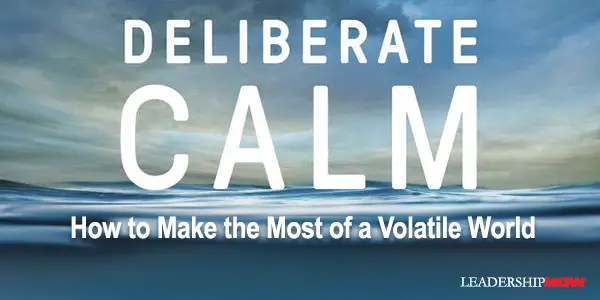
CHAOS and uncertainty are a part of life. Are you making the most of it? To make the most of a turbulent world we need to be able to balance our emotions with a rational and deliberate thought process in real time that allow us to learn and thoughtfully and creatively move through the circumstance or what authors Jacqueline Brassey, Aaron De Smet, and Michael Kruyt, call Deliberate Calm. Here’s the problem. At the very moment, we need to thoughtfully address the situation and select the behavior best suited for it, we instinctively do the opposite. In Deliberate Calm: How to Learn and Lead in a Volatile World, the authors refer to this as the Adaptability Paradox: “ At the very moment when we need to break free from our habitual patterns and creatively engage with the unfamiliar, complex, or uncertain situation and choose a new and innovative response, it is the very unfamiliarity, complexity, and lack of certainty that render us unable to do so.” Deliberate calm is about adaptability and self-mastery. It is about awareness, learning agility, and emotional self-regulation. Beneath the surface of our behavior is our core identity, made up of thoughts, feelings, and beliefs that we have developed and refined since childhood. Negative self-talk only reinforces this. Together they form the foundation of the mindset that sets in motion our behavior. Mostly this seems to work for us. It seems to protect us and our core identity. But in volatile situations, our ingrained reactions cause us to miss opportunities to learn and grow in more productive ways. The ability to detach ourselves from our thoughts and feelings is the first step forward. We need to develop Dual Awareness. Dual Awareness is having an “awareness of both our external and internal environments and how they impact each other.” Being able to do this means “we can recognize that our intense feelings are actually gifts. They are messages telling us that our typical behaviors may not be the best fit for the situation we are facing.” Dual Awareness has three layers: awareness of the situation and what it calls for, awareness of what is going on for you in the moment, and then responding effectively as a result. This helps us to recognize when we have entered an Adaptive Zone. In this zone, “we are facing challenges that require us to do something new that isn’t easy or natural for us to do, and if we fail, there are real consequences. The circumstances have outgrown our existing capabilities, and our normal habits, patterns, and behaviors no longer work for us the way we need or want them to.” When faced with an Adaptive Zone, it is time to shift into learning mode. Our default mindset can create blind spots. In those moments, however, we can accept and acknowledge our limited view, learn from the experience of others, and try to see things through their lens, we will expand our view of the world and solve far more complex problems than we ever could on our own. The question then becomes, “What would I need to believe in order to respond differently?” When we find ourselves in an Adaptive Zone, it is common “for all of us to blame others for our problems when we are in protection and operating from our default mindset and behavior patterns. We believe that the way we are seeing things is objectively true, so we do not look inward and examine other possibilities or the ways in which our own point of view might be skewed. This leads us to blame others or circumstances outside ourselves for our problems instead of taking ownership and finding ways we can change to create a better outcome.” We easily cling to what we know and what has worked for us in the past in the face of uncertainty, even though it is not working because it is comfortable and gives a sense of control. Having an overriding purpose helps us to remember why we do what we do and helps move us out of the familiar and embrace the Adaptive circumstance we face and learn from it. When two different mindsets collide, we typically find conflict. But “when handled well, with an open mind instead of judgment, defensiveness, or blame, conflict can in fact, be a major catalyst for learning.” Without Dual Awareness, we run the risk of being triggered in a state of protection, judging and blaming others, and beginning to form negative opinions about them. Then we perceive what they say and do in light of those opinions. The path to practicing Deliberate Calm is to “consciously design your life so it is easier to remain grounded and present no matter what is going on around you.” The Deliberate Clam model rests on four pillars: awareness, purpose, relationships, and energy. The book’s appendix provides a way to access where you are and create daily practices that will help you develop your Deliberate Clam muscle.

Posted by Michael McKinney at 07:26 AM
01.12.23

Leading Thoughts for January 12, 2023
IDEAS shared have the power to expand perspectives, change thinking, and move lives. Here are two ideas for the curious mind to engage with: Nathan and Susannah Furr on uncertainty: “Behind every uncertainty you are facing—even the unwanted and unpromising varieties—insight, growth, and possibility are waiting in the wings. We are all wired to fear the downsides of uncertainty, but we forget that change, creation, transformation, and innovation rarely show up without some measure of it.” Source: The Upside of Uncertainty: A Guide to Finding Possibility in the Unknown / (Blog Post) Scott Sonenshein on pushing ourselves into action: “The wait for the ‘right’ resources can be long or even never-ending, but acting immediately teaches us to appreciate and work with what we do have.” Source: Stretch: Unlock the Power of Less—and Achieve More Than You Ever Imagined / (Blog Post) Look for these ideas every Thursday on the Leading Blog. Find more ideas on the LeadingThoughts index.
Posted by Michael McKinney at 08:09 AM
01.09.23

Embrace the New Norm by Listening to Your Employees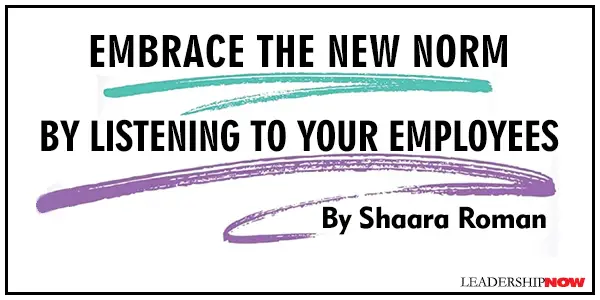
AFTER a tumultuous couple of years, the majority of the U.S. workforce is disengaged, burned out, and fed up. The work-life balance mindset has become increasingly prevalent, and people are taking major steps back from the workplace bustle. Many people are becoming less motivated in their jobs and leaders are stuck wondering what to do. The answer is simple - listen. Listening to your employees’ complaints, wants, and needs goes a long way. It’s very obvious what the workforce needs to stay motivated because they are being very vocal about these shifts in priorities. When Millennials entered the workforce, they prioritized “work to live” and did not want any part of the “hustle culture” that prioritizes face time, long hours, paying your dues. Gen Z feels the same way. In addition, research continually shows that Millennials and Gen Z’s in particular, plus an increasing number of other generations, are wanting to work in places that are committed to diversity, equity, and inclusion. They want their voice and opinions heard, they want to feel valued for their contributions, and they want flexibility to work how, where, and when they want. People have always wanted to do interesting work, they want flexibility, they want to grow their skills, they want to work in places where the culture allows them to thrive. The difference now is that people have seen that that’s a real possibility, so they are having a hard time going back to ‘the old norm.’ They are fighting for what they want, and organizations that don’t meet them in the middle will simply be left behind. COVID has made everyone examine their relationship with work and now millions of workers are opting out – whether it’s to take a sabbatical or join a new firm or start their own gig or do something totally different. The old-time view of grinding your way to the top is not only outdated it also puts you on the fast train to burn out, and no one wants that. Our world is also moving at a rapid pace and the constant barrage also adds to the burnout we are all experiencing. Right now, the power rests with the workforce – and will continue to do so even through a predicted recession. They are telling us in many ways that the status quo is not acceptable. Droves of women left the workforce in 2020. Millions have joined the great resignation, and over two-thirds of the workforce is disengaged or a part of the “quiet quit.” This is an opportunity for leaders to step up, lean in, and engage their staff to ask what would work for them and then work to make it a reality. Organizations that stand any chance of making it to the future of work will do the following:
We are on the heels of the future of work. Our nation’s workforce is undergoing a major transformation in attitude and priorities. What motivated someone 5 years ago - even two or three years ago - is not the same thing that motivates that same person today. Organizations that continue to ignore/resist this shift and try to force old processes are setting themselves up for failure. In order to motivate your employees, you just have to listen and embrace change.  
Posted by Michael McKinney at 06:27 AM
01.06.23

Why Is This Happening for Me?
IN 1954, Dr. Julian Rotter began measuring what he called a student’s locus of control. He said you either had an external locus of control or an internal locus of control. Those with an external locus of control believe that fate or external forces control the outcomes of their lives. Life is happening to me. They are so busy reacting to life that they’ve turned everything over to others—it is someone else’s responsibility. For example, to say, “A professor gave me a bad grade,” reflects an external locus of control. This happened to me. “They did this, so I had to do that.” People with an internal locus of control are people who believe that they are responsible and in control of their own success. They take personal responsibility. “I own this.” Your perspective on a problem will determine your experience in dealing with it. Your experience is based on your perspective. You usually can’t control what is happening to you, but you can control your perception of it and, thus, how it affects you. If you have an external locus of control, then you flat-out don’t believe that. You need to shift your focus. It’s not an easy shift to make. I know. It is natural to turn inward when in the midst of a problem or disruption. But the way out, the way to healing, is to see your problem as part of a larger whole—a different context. We must expand our thinking. Every problem has the potential to give you a firmer foundation from which to deal with the next disruption. It builds resilience. To get where you want to go, you’ve got to go through the stuff that you’re in the middle of. Perseverance implies a process—a journey. And it is in that journey, if we stick with it—if we persevere—that we develop maturity and completeness. Our tendency in this journey is to try to avoid all of the discomfort, disruptions, and problems that come our way. We fight against it. We need to reframe that. It’s not about what you are fighting against but rather understanding what are you fighting for? We are fighting for resilience. We are fighting for strength. We are fighting for perseverance. We are fighting for patience. We are fighting for growth. We are fighting for hope. Instead of asking, “Why is this happening to me?” ask, “Why is this happening for me?” You can redeem your circumstance. So many times, I think all of us can look back and think, “Wow. I would never have become the person I am today without what happened to me. I wouldn’t have chosen it. I wouldn’t wish it on anyone else, but it built something valuable in me. And I’m better for it.”
Posted by Michael McKinney at 08:47 AM
01.05.23

Leading Thoughts for January 5, 2023
IDEAS shared have the power to expand perspectives, change thinking, and move lives. Here are two ideas for the curious mind to engage with: Ed O’Malley and Julia McBride on asking, “What’s my part of this mess?”: “One person can see a problem, get more curious about it, and use their influence to make things better. But real change begins when lots of people get curious about what’s really going on with a problem or challenge.” Source: When Everyone Leads: How The Toughest Challenges Get Seen And Solved Journalist and essayist Pico Iyer on uncertainty: “We’re always living in a state of uncertainty — two years ago, two years from now — and that therefore, part of our challenge as I see it is to make uncertainty our church in New Jersey — to make it our home. This is where we’re living, every day of our lives. And so, as you said, let’s rejoice in it, furnish it, close the door, rearrange the books, and say, Make this as beautiful as it can, given that forest fire, earthquake, or who knows what will be coming tomorrow — or tremendous beauty and love may be coming in the door tomorrow.” Source: Pico Iyer interviews with Elizabeth Gilbert, The Future of Hope Series Look for these ideas every Thursday on the Leading Blog. Find more ideas on the LeadingThoughts index.
Posted by Michael McKinney at 08:34 AM
01.02.23

The Upside of Uncertainty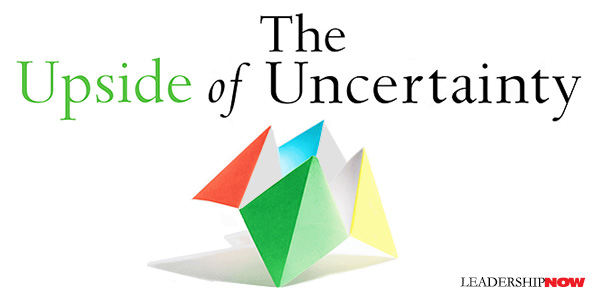
IN The Upside of Uncertainty, Nathan and Susannah Furr assert that “Behind every uncertainty you are facing—even the unwanted and unpromising varieties—insight, growth, and possibility are waiting in the wings. We are all wired to fear the downsides of uncertainty, but we forget that change, creation, transformation, and innovation rarely show up without some measure of it.” That’s not to say that there are no real downsides. We feel them first: anxiety, stress, exhaustion, frustration, and confusion. Uncertainty, as they define it, is “anything unknown, any ambiguous state where you might not even know what to pay attention to, let alone all the ways it could play out.” In contrast to risk, uncertainty does not include any knowable outcomes—no probabilities to factor in. It is uncharted territory. But uncertainty presents us with possibilities that emerge that can help to not only navigate the situation but thrive in it and beyond it. To do this, the authors present us with tools to help us with the unknown. While some of the tools overlap, they divide them into four categories: Reframe, Do, Sustain, and . They go into detail describing how to implement each of the tools in all four categories.
REFRAME Reframe tools enable and strengthen a perspective shift, motivating you to look creatively for all the possibilities and to believe in an upside that you can’t see yet. Discovering the upside of uncertainty starts with undergoing a radical shift in perspective: Instead of fearing and avoiding the unknown, you recognize and embrace it as the origin of possibility. The Reframe tools are largely cognitive in nature, meaning they are about how you make sense of the world. PRIME Prime tools prepare you by encouraging projects that matter to you, taking into account your personal uncertainty landscape to enable satisfying outcomes when it’s time to act. The Prime tools are situated on the “doing” axis, inviting you to start taking steps toward any uncertainties you face. These include both the uncertainties you choose, such as starting a new project or adventure, and those you don’t, such as unexpected loss or downturn. DO Do tools describe how to thoughtfully unlock rewarding possibilities hidden in the uncertainties you face to promote a future you want to live in. As you implement the Do tools, remember that what happens in the future depends on the “conversations” you are willing to have, then give yourself permission to boldly engage with what’s already been done to create new possibilities. Anything and everything can be recomposed. SUSTAIN Sustain tools give comfort and remind you why and how to keep going or how to pivot when things don’t go as planned. Sustain tools are most helpful in a time of crisis. Sustain tools nourish and comfit you through the downsides of uncertainty. Regret, anxiety, grief, self-doubt, and even embarrassment can be powerful obstacles to navigating uncertainty as well. The symbol used to represent Sustain is the Paris coat-of-arms containing a boat floating above turbulent water with the Latin motto fluctuat nec mergitur or tosses but not sinking. While facing the reality of your circumstances may bring “challenge, discomfort, and heartache, it is the only place where innovation, solution, and evolution happen.” The authors encourage us to go beyond just being resilient to transilience. Transilience “is about transformation, leaping from one state to another.” To recap, there are four critical things to remember when faced with uncertainty:

Posted by Michael McKinney at 10:06 AM
01.01.23

First Look: Leadership Books for January 2023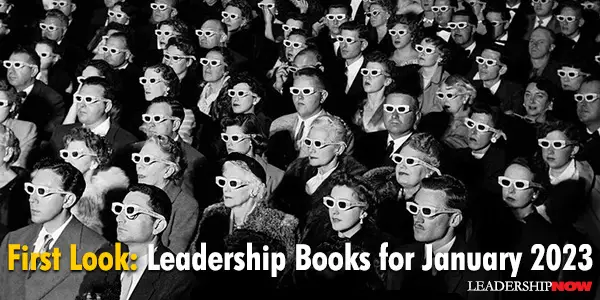
HERE'S A LOOK at some of the best leadership books to be released in January 2023 curated just for you. Be sure to check out the other great titles being offered this month.
Leadership is engaging others to solve daunting challenges. Those challenges appear in our professional lives, in our communities, our families―and they seem unsolvable, beyond our ability to see what needs to be done or outside our capacity to make the changes needed. They are not. Because, leadership is an activity―small actions taken in moments of opportunity. And as you start to look around, you can begin to see more of those moments, seize the opportunity in those moments. Most importantly, you can help others see those opportunities too.
When was the last time you pushed yourself beyond your comfort zone and dared to fail? In Disruptable, Allan Young shows you how embracing your different, getting outside your comfort zone, observing the impossible, daring to fail, and taking purposeful action will set you on a path of intentional personal disruption that will change your world forever. If you are ready to face your fears and embrace your failures, you can also enjoy the freedom of limitless growth.
A tale of mentorship, hard truths, and the path to success. In this fictional account of an entrepreneur's rollercoaster ride to the top, Cap Treeger crafts a series of dynamic, well-drawn lessons for anyone that wants to start or build a business. The hero of the story, Ren, is fired up with ambition and has a strategic dream in place to build his own startup from the ground up, but he has a lot to learn about how this particular sector of the business world works. Ren's journey guides readers through numerous factors necessary for success, including building a solid team with strategic placement of individuals in carefully selected roles appropriate to their skill sets and crafting the all-important business model. Ren navigates the daunting process with grace and hands readers an account loaded with insight-rendering Finding the Way, told in a straightforward and reader-friendly manner, a valuable gem amidst business-building literature.
Essential reading for any executive, Into the Metaverse, will reshape how you think about the internet and its place for those who want to lead successful businesses, today and into the future. If the internet was first used to connect us to information, and then developed into a social media forum to connect people, then Web3, which connects people, places and things, will help enable the successor state to today's mobile internet - the Metaverse. It will bring together and merge our physical and digital lives, and - in the same way that social media upended our lives and our businesses - the Metaverse will shake things up even more. Into the Metaverse is the essential business guide to understanding the ground-breaking technologies that enable this monumental shift and the opportunities it presents from a business and societal perspective.
Why so much hoopla over a successful car wash? Roughly 80 percent of Rising Tide’s workforce consists of people with autism. While part of the success comes from their mission, that doesn’t explain the excellence that permeates every aspect of the business: service quality, customer experience, teamwork, management, and organizational design. The Power of Potential tells the inspiring, surprising reason why: The wash’s excellence isn’t in spite of their unusual workforce, but because of it. Thanks to their unconventional staff, the Rising Tide team was able to discover and correct common problems that typically fly under the radar in businesses. By spotting and correcting these hidden problems, any business, with any kind of workers, can achieve unexpected wins and leave average behind. The common problems include: You Hire Based on Interviews, You Think Great Talent Is the Secret to a Great Business, Your Managers Are “Good Enough,” and You Fire Your Worst Employees. To our surprise, solving the four problems changed who we were as a company. The result was four unexpected wins that added up to a culture of excellence—but leadership is needed to reinforce what matters.
Leading in a Non-Linear World leads readers through a groundbreaking set of science-based strategies to help them face rising demand, uncertainty and change posed by disruptive technologies and seismic shifts in globalisation. The book shows how our mindset, more than our knowledge and expertise, has the potential to be our greatest asset in facing the future. Jean Gomes reviews the latest brain research revealing that our mindset is the interplay of feeling, thinking, and seeing, and how we can build it to significantly increase our wellbeing and performance.
 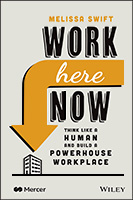 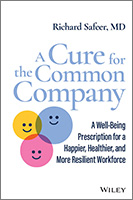 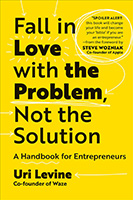
New Edition of Classic Leadership Book:
“A library is not a luxury but one of the necessities of life.” — Henry Ward Beecher
Posted by Michael McKinney at 08:11 AM
|
BUILD YOUR KNOWLEDGE


How to Do Your Start-Up Right STRAIGHT TALK FOR START-UPS 
Grow Your Leadership Skills NEW AND UPCOMING LEADERSHIP BOOKS 
Leadership Minute BITE-SIZE CONCEPTS YOU CAN CHEW ON 
Classic Leadership Books BOOKS TO READ BEFORE YOU LEAD |
|